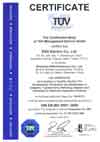

Request-for-Quote form "Help"
Type of unit:
- A wall-mount unit is a "direct" plug-in and goes directly
to the wall or other power outlet. A desk-top does not go directly to
the wall outlet but rather "indirectly" by way of an input power
cord.
- Linear adapters are the least expensive, heavier, unregulated is standard.
Switching adapters are "electronic" and allow for lighter design
and universal inputs, automatically have regulated outputs...but are more
expensive. If you would like to leave our switching section, please visit
the linear wall-mount page
or linear desk-top page.
Desk-Top section:
This option needs be selected only if you are looking for a desk-top supply
as the options listed do not apply to wall-mount units.
- Inlet Receptacle. This is the inlet on the power-in side of the power
supply. It will mate with a power input cord that will then plug into
the wall or other power receptacle.
| C6 |
C8 |
C14 |
- Quote on the input cord? Check the "yes" box and ENG to provide
you a quote on the cord with the power supply...or "no" if you
want the power supply only quoted (you will supply the required power
cord). Please note that if we are to quote the input cord, you will need
to advise on the "input prongs" needed in the following section.
- Input Cord. Please select the input cord length needed. Of course, if
you do not need us to quote on the input cord, you do not need to fill
out the required length.
Input Prongs:
Please enter the type of input prongs that you desire for this unit. This
will be the side supplying the unit with power (input). Go to the Input
Prong page.
Input Rating:
Please enter the required AC input voltage (VAC) and frequency (Hz) for
the adapter. This is the input rating of the adapter. For example, in
the U.S.A. the input rating is 120Volts 60Hz. Most of our switching supplies
have a universal input of 90 to 256 Volts 50/60Hz.
Output:
DC is the default as a switcher automatically has DC output. AC = alternating
current and DC = direct current.
Output Voltage:
Enter the output voltage needed to power the device that you will plug
this adapter into.
Output Current:
Enter the current in either mA (milliAmps) or A (Amps). This will be the
current needed to power the device that you will plug our adapter into.
Output Regulation:
Switching power supplies by default are regulated units. Regulation controls
the output (does not allow it to change greatly) when the input voltage
and/or load current are varied. The output can only be regulated if it
is DC. Most applications do not require regulation. If you are not sure,
choose un-regulated. Regulation adds significant cost. Again, regulation
is automatically included for a switching power supply.
Output Cord:
Enter the length of the cord needed to go from our supply to the device
you need to power. Standard is 6 feet long.
Output Plug/Length/Polarity:
- At the end of the above mentioned power cord, there will be a plug that
will mate with the device you are powering. Enter the type of output plug
needed to mate with the device our adapter will power. For a complete
list of our available plugs click
here. In addition, you can select no plug options of "stripped
and tinned", or "blunt cut" ends of the output cord.
- The length of the output plug can typically be between 9 and 14mm.
- As switchers are DC by default, we also need to know the polarity of
your selected output plug...the center or tip can be either positive or
negative. Polarity is not an issue for AC output devices.
Ambient Temperature:
The still-air temperature of the environment in which the adapter/transformer
is operating. e.g., "room temperature", which is standard.
Safety Agency Approvals:
- See our Safety Agency
page for complete details on many world-wide agencies. For most North
American applications, UL and cUL will suffice. See the above page as
well as our cUL page
for more details on cUL which is the equal of CSA. There are also pages
on CSA and on the
new UL logos.
- The drop down box for this field gives the most common options, but
as mentioned, the above pages give additional information and specific
agency contact information should you be unsure of what you need.
Quote Quantities and FOB Point:
- On catalog units we can quote as low as 250 pieces, and for custom this
usually goes to 1k pieces (however approval charges and such may make
this go higher).
- The FOB Point is the location from which the customer takes possession
of the goods and from which point they cover all freight, duty, and other
charges. For instance an FOB Point of Chicago, IL would mean that ENG
would have taken care of all freight and duty charges getting the parts
to this point. The customer would only have to "truck" the parts
from Chicago to their location. Even in this case, ENG will advise the
trucker to pick up and deliver the parts to your location on your account.
© 2012 ENG Electric Company. All rights reserved.
Commercial use of images, forms, & data on this site is not permitted.